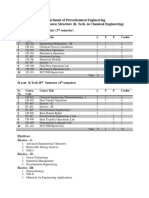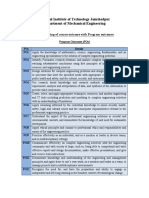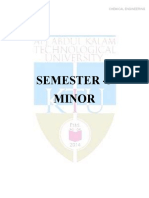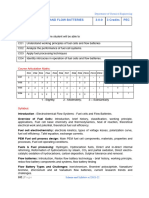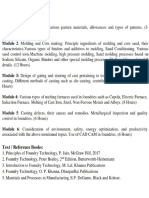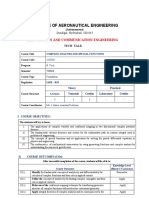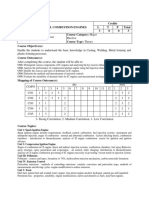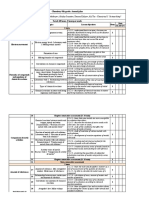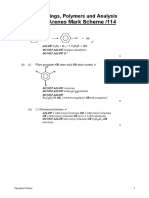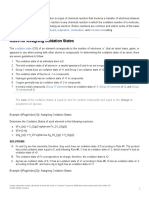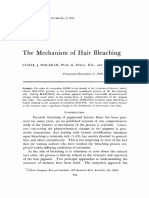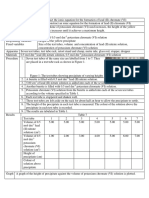Regulation 2018 Semester I /semester II Total Hours 90 Category Course Code Course Name Hours / Week C L T P
Regulation 2018 Semester I /semester II Total Hours 90 Category Course Code Course Name Hours / Week C L T P
Uploaded by
Geetha SCopyright:
Available Formats
Regulation 2018 Semester I /semester II Total Hours 90 Category Course Code Course Name Hours / Week C L T P
Regulation 2018 Semester I /semester II Total Hours 90 Category Course Code Course Name Hours / Week C L T P
Uploaded by
Geetha SOriginal Description:
Original Title
Copyright
Available Formats
Share this document
Did you find this document useful?
Is this content inappropriate?
Copyright:
Available Formats
Regulation 2018 Semester I /semester II Total Hours 90 Category Course Code Course Name Hours / Week C L T P
Regulation 2018 Semester I /semester II Total Hours 90 Category Course Code Course Name Hours / Week C L T P
Uploaded by
Geetha SCopyright:
Available Formats
Regulation 2018 Semester I /Semester II Total Hours 90
Course Hours / Week
Category Course Name C
Code L T P
B 18CYB101J CHEMISTRY 3 1 2 5
Prerequisite Course (s)
NIL
Course Objective (s):
The purpose of learning this course is to:
Apply the basic principles of chemistry at both atomic and molecular levels in understanding the
concepts related to the engineering field.
Integrate the chemical principles in their projects undertaken in their respective fields
Enhance the quality of a materials used in the product from the technological aspects for societal
applications
Course Outcome (s) (Cos):
At the end of this course, learners will be able to:
CO1 Identify the suitable polymeric materials fabrication processes in various application
CO2 Apply the basic principle of inorganic chemistry at the atomic and molecular levels
CO3 Apply the various thermodynamic and kinetics concepts to real system
CO4 Assemble a battery through the understanding of electrochemical principles
CO5 Catagorize the Engineering materials for their applications
CO-PO Mapping
POs PSOs
COs PO PO PO PO PO PO PO PO PO PO1 PO1 PO1 PSO PSO PSO
1 2 3 4 5 6 7 8 9 0 1 2 1 2 3
CO1 3 3 - - - - - - - - - - - - -
CO2 3 3 - - - - - - - - - - - - -
CO3 3 3 - - - - - - - - - - - - -
CO4 3 3 - - - - - - - - - - - - -
CO5 3 3 - - - - - - - - - - - - -
CO
3.00 3.00 - - - - - - - - - - - - -
(Avg)
1: Slight (Low) 2: Moderate (Medium) 3: Substantial (High)
Curriculum and Syllabus | 2018 Regulation
UNIT I ENGINEERING ORGANIC MATERIALS 9*+3*
Polymer – Introduction- classification(based on molecular weight, structure and usage)- types of
polymerization(Addition, Condensation and Copolymerisation)-crystallinity, melting point and glass
transition temperature-mechnism of polymerization(free radical addition polymerization)-elastomer-
structure and curing(vulcanization)- Fabrication and molding of polymers(Injection molding and blow
molding)- Engineering plastics – PE, PVC, PMMA, Phenol formaldehyde resin , urea formaldehyde
resin( Preparation, properties and uses)- Industrial applications of polymers.
UNIT II COORDINATION AND ORGANOMETALLIC COMPOUNDS 9*+3*
Co-ordination compounds – Introduction- nomenclature- types of ligands (mono, di and poly dendate
ligands)-isomerism(structural and stereo isomerism) – theories of bonding( Werner and Sidgwick Pouvell
theory(EAN rule)) – applications – EDTA titration – Organometallic compounds - synthesis( organo zinc,
organo Lithium and Organo magnesium) – Applications ( 18 electron rule, Ziegler Natta Catalyst and
Hydroformylation)
UNIT III THERMODYNAMICS AND KINETICS 9*+3*
Introduction- first and second law of thermodynamics – Gibbs –Helmholtz equation – Clausius clapeyron
equation – Maxwell relations – Vant hoff isotherm and Isochore (problems also)- Kinetics- Introduction-
types of reactions(opposing, consecutive and parallel reactions)- chain reactions (HBr and HCl formation)-
Applications of kinetics and thermodynamics.
UNIT IV ENGINEERING ELECTROCHEMISTRY 9*+3*
Introduction- Conductors and its types - cells ( Electrolytic and Electrochemical cells) – Standard electrode
potential- Nernst equation of an electrode- types of electrodes ( SHE and Calomal electrode)- Batteries –
Types ( Primary, Secondary, Flow and reserve battery)- Examples ( Lead acid battery, Ni-Cd battery,
Lithium battery, Lithium sulphur battery and Hydrogen- Oxygen fuel cells)- Graphene.
UNIT V INDUSTRIAL APPLICATIONS OF CHEMISTRY 9*+3*
Cement (Types, manufacture and properties) – Paints ( constitutions and functions )- Lubricants- types-
mechanism – properties-abrasives – types –Diamond, Corundum, emery, garnet, quartz, Silicon carbide,
carborundum-boron carbide, alundum (preparation, properties and uses ) –applications – Basics of biosensor
and biochips.
LIST OF EXPERIMENTS 30
1. Determination of total , permanent and temporary hardness of water sample (EDTA method)
2. Determination of alkalinity in water sample- Indicator method
3. Determination of chloride content of water sample by Argentometric method(Mohr’s method)
4. Determination of dissolved oxygen content of water sample by winkler’s method
5. Conductometric titration of strong acid with strong base
Curriculum and Syllabus | 2018 Regulation
6. Conductometric titration of mixture of acids
7. Determination of strength and amount of Hydrochloric acid- pH metry
8. Estimation of strength and amount of ferrous ion by potentiometric method
9. Determination of molecular weight of a polymer by viscometry method
10. Estimation of ferrous ion by colorimetry.
11. Cement analysis
Text / Reference (s) books:
1 B.L.Tembe, Kamaluddin and M.S.Krishnan , “Engineering chemistry”
2 S.S. Dara “A Text book of Engineering Chemistry” S.Chand & Co.Ltd, New Delhi (2009).
3 P.C.Jain and Monica Jain, “Engineering Chemistry” Dhanpat Rai Pub, Co., NewDelhi (2012).
4 Shashi Chawla, Engineering Chemistry: Dhanpat Rai &Co., 3rd Edition, 2015
5 www.nptel.ac.in
Curriculum and Syllabus | 2018 Regulation
You might also like
- J of Separation Science - 2012 - Hahn - Methods For Characterization of Biochromatography MediaDocument32 pagesJ of Separation Science - 2012 - Hahn - Methods For Characterization of Biochromatography MediaMarco RossiNo ratings yet
- Cation Anion WorksheetDocument1 pageCation Anion Worksheetakbaby514100% (2)
- Department of Chemical Engineering Proposed New Course Structure (B. Tech. in Chemical Engineering)Document33 pagesDepartment of Chemical Engineering Proposed New Course Structure (B. Tech. in Chemical Engineering)Akash BodekarNo ratings yet
- 18PYB101JDocument4 pages18PYB101JPERIYASAMY BALAMOORTHYNo ratings yet
- Compiled Sylla - Petro II Year 1Document34 pagesCompiled Sylla - Petro II Year 1barhatekrudhnaNo ratings yet
- 22CH130 Syllabus Chem 2022Document4 pages22CH130 Syllabus Chem 2022harsshakannan27No ratings yet
- Kec r2020 Mech Syllabus R&acDocument2 pagesKec r2020 Mech Syllabus R&actamilvananirttNo ratings yet
- Material Testing LaboratoryDocument2 pagesMaterial Testing LaboratoryKaran Gupt.No ratings yet
- 22ME240 Engineering Thermodynamics: Category L T P C Terminal Exam Type PCC 3 - 3 TheoryDocument4 pages22ME240 Engineering Thermodynamics: Category L T P C Terminal Exam Type PCC 3 - 3 TheoryShankarNo ratings yet
- IV Sem - FMMDocument2 pagesIV Sem - FMMposr2akNo ratings yet
- 2nd Year CO-PO Mapping FinalDocument14 pages2nd Year CO-PO Mapping FinalsantoshNo ratings yet
- P23. Mapping of Course Outcome With Program OutcomesDocument31 pagesP23. Mapping of Course Outcome With Program OutcomesBhaskar MondalNo ratings yet
- 20CHT394-Advanced Wastewater Treatment TechniquesDocument6 pages20CHT394-Advanced Wastewater Treatment TechniquesULLAS KRISHNAN J NNo ratings yet
- Automoius Sem III & IV SYLLABUSDocument21 pagesAutomoius Sem III & IV SYLLABUS10rajNo ratings yet
- 15mel67 - Heat Transfer Laboratory ManualDocument95 pages15mel67 - Heat Transfer Laboratory ManualMohan Kumar KNo ratings yet
- Cop Other MalDocument2 pagesCop Other MalVpr NaturalsNo ratings yet
- 20ME403 Engineering Materials and Metallurgy Unit - 1 Digital MaterialDocument55 pages20ME403 Engineering Materials and Metallurgy Unit - 1 Digital MaterialDark ranger YtNo ratings yet
- BEE CO PO Mapping 2018 ExternalQPDocument1 pageBEE CO PO Mapping 2018 ExternalQPLeela KrishnaNo ratings yet
- 5 Semester MU-301: Dynamics of Machines Course Outcomes: After CO StatementDocument6 pages5 Semester MU-301: Dynamics of Machines Course Outcomes: After CO StatementchkrmechNo ratings yet
- 5 Semester MU-301: Dynamics of Machines Course Outcomes: After CO StatementDocument6 pages5 Semester MU-301: Dynamics of Machines Course Outcomes: After CO StatementEric CookNo ratings yet
- Academic Content: Engineering ChemistryDocument218 pagesAcademic Content: Engineering ChemistryVIVEK SINGHNo ratings yet
- Chemical EngineeringDocument9 pagesChemical EngineeringanushafiNo ratings yet
- Storage Technologies Syllabus (Repaired)Document2 pagesStorage Technologies Syllabus (Repaired)Gopal KrishnaNo ratings yet
- 5 Semester MU-301: Dynamics of Machines Course Outcomes: After CO StatementDocument6 pages5 Semester MU-301: Dynamics of Machines Course Outcomes: After CO Statementmumtaz alamNo ratings yet
- SyllabusDocument2 pagesSyllabusPrabhakara Rao Peeka100% (1)
- Basics - of - Civil & Mechanical Eng.Document7 pagesBasics - of - Civil & Mechanical Eng.Rahul J.RNo ratings yet
- SyllubusDocument2 pagesSyllubusPERUMALLA SAIKUMARNo ratings yet
- 20ME403 Engineering Materials and Metallurgy Unit - IV Digital MaterialDocument55 pages20ME403 Engineering Materials and Metallurgy Unit - IV Digital MaterialDark ranger YtNo ratings yet
- 4 Semester MU-202: Kinematics of Machines Course Outcomes: After Completion of This Course, The Successful Students Will Be Able To: CO StatementDocument6 pages4 Semester MU-202: Kinematics of Machines Course Outcomes: After Completion of This Course, The Successful Students Will Be Able To: CO StatementEric CookNo ratings yet
- Chemistry I (CH 101orch201)Document5 pagesChemistry I (CH 101orch201)Singham shekNo ratings yet
- M TechsyllabusbeDocument30 pagesM Techsyllabusbeaarya adarsh kumar aryaNo ratings yet
- MECHANICALDocument69 pagesMECHANICALSelvakumar SubbaiahNo ratings yet
- First Year Syllabus - 2022-23Document25 pagesFirst Year Syllabus - 2022-23Art SplashNo ratings yet
- Microwave 6th Sem 2018 2019Document23 pagesMicrowave 6th Sem 2018 2019Nk RahulNo ratings yet
- 7th Sem SyllabusDocument6 pages7th Sem SyllabusAshwit KumarNo ratings yet
- Chemistry Notes 18CHE12 (All. Websites)Document94 pagesChemistry Notes 18CHE12 (All. Websites)arpitaNo ratings yet
- Institute of Aeronautical Engineering: Electronics and Communication EngineeringDocument5 pagesInstitute of Aeronautical Engineering: Electronics and Communication EngineeringanuNo ratings yet
- 3.syllabus) BoS - Civil Engineering - RGUKT APDocument191 pages3.syllabus) BoS - Civil Engineering - RGUKT APuhagadiNo ratings yet
- B e Cse3Document3 pagesB e Cse3Chindiyababy UNo ratings yet
- Syllabus of Foundation Compulsory Courses: CO CO1 CO2 CO3 CO4 CO5Document2 pagesSyllabus of Foundation Compulsory Courses: CO CO1 CO2 CO3 CO4 CO5TALHA PARVEZNo ratings yet
- Bme 513Document4 pagesBme 513panditankitg1No ratings yet
- MFT I SyllabusDocument3 pagesMFT I SyllabusVamsi RockzzNo ratings yet
- C20 - Revamping - M 303 TSESDocument12 pagesC20 - Revamping - M 303 TSESdilchintala25phdNo ratings yet
- RR - Lesson Plan, BMEDocument3 pagesRR - Lesson Plan, BMErpaacharyaNo ratings yet
- B.tech Chemical Engineering, AmuDocument82 pagesB.tech Chemical Engineering, Amukeepingthefaith.izharNo ratings yet
- Comprehensive Course WorkDocument5 pagesComprehensive Course WorkNandulal KrishnaNo ratings yet
- Mec312 Internal Combustion EnginesDocument2 pagesMec312 Internal Combustion EnginesrockmanmaxNo ratings yet
- Elect - Lesson Plan, BmeDocument3 pagesElect - Lesson Plan, BmerpaacharyaNo ratings yet
- DR JPS FM 6feb - New - FormatDocument3 pagesDR JPS FM 6feb - New - Formatdiksha singhNo ratings yet
- Syllabus Mechanical IInd SemDocument3 pagesSyllabus Mechanical IInd Semlikithaswath2No ratings yet
- 8th SemesterDocument28 pages8th SemesterdipuNo ratings yet
- Piping SystemDocument2 pagesPiping SystemBabu NarayananNo ratings yet
- CE8394 Fluid Mechanics and Machinary PDFDocument80 pagesCE8394 Fluid Mechanics and Machinary PDF18M129 Manjeeth SNo ratings yet
- Jadavpur University: Faculty of Engineering and TechnologyDocument65 pagesJadavpur University: Faculty of Engineering and TechnologyArchisman HazraNo ratings yet
- AO 4101 - SyllabusDocument2 pagesAO 4101 - SyllabusrajakannikaiesNo ratings yet
- Met 205Document9 pagesMet 205DrRoja A RNo ratings yet
- 3 AS AMP SyllabusDocument3 pages3 AS AMP SyllabusBrute ForceNo ratings yet
- Syllabus AMIDocument2 pagesSyllabus AMIMathavaraja JeyaramanNo ratings yet
- Design Lab Manual GLA NEWDocument36 pagesDesign Lab Manual GLA NEWFirst LastNo ratings yet
- Nanotechnology Commercialization: Manufacturing Processes and ProductsFrom EverandNanotechnology Commercialization: Manufacturing Processes and ProductsNo ratings yet
- Durability Design of Concrete Structures: Phenomena, Modeling, and PracticeFrom EverandDurability Design of Concrete Structures: Phenomena, Modeling, and PracticeNo ratings yet
- Chemical Bonding-Bansal (JEE) PDFDocument7 pagesChemical Bonding-Bansal (JEE) PDFMadhur GuptaNo ratings yet
- Polyolefins 170917074212 PDFDocument26 pagesPolyolefins 170917074212 PDFTrinh Đình VũNo ratings yet
- 8 Grade Annual PlanDocument7 pages8 Grade Annual PlanAkniet RysbekovaNo ratings yet
- Application of Nanosize Zeolite Molecular Sieves For Medical Oxygen ConcentrationDocument19 pagesApplication of Nanosize Zeolite Molecular Sieves For Medical Oxygen ConcentrationAla Ibrahim JalladNo ratings yet
- Berr ChemDocument50 pagesBerr ChemBerrNo ratings yet
- Balancing Redox Reactions in General Chemistry 2Document2 pagesBalancing Redox Reactions in General Chemistry 2STEM11B Manlapaz Jose Gabriel P.No ratings yet
- Arenes Questions EdexcelDocument10 pagesArenes Questions EdexcelNyraStardollNo ratings yet
- CV (LATEST) UsamaDocument8 pagesCV (LATEST) UsamaSardar Usama YousafNo ratings yet
- Capstone EnviDocument27 pagesCapstone EnviNicole ValmonteNo ratings yet
- Exogenic Processes or Denudation: 2 Semester: Earth ScienceDocument5 pagesExogenic Processes or Denudation: 2 Semester: Earth ScienceLeshauna CaleighNo ratings yet
- Seaweed Study (RRL For Soil Burial)Document16 pagesSeaweed Study (RRL For Soil Burial)Princess Jesselen EnriquezNo ratings yet
- Oxidation Reduction ReactionsDocument6 pagesOxidation Reduction ReactionsKyla AngelleNo ratings yet
- Nanoemulsions and Topical Creams For The Safe and Effective Delivery of Lipophilic Antioxidant Coenzyme Q10Document24 pagesNanoemulsions and Topical Creams For The Safe and Effective Delivery of Lipophilic Antioxidant Coenzyme Q10Raghavendra NaveenNo ratings yet
- Cocl 6 NH Orange-Yellow Cocl 5 NH H O Red Cocl 5 NH Purple Cocl 4 NH GreenDocument3 pagesCocl 6 NH Orange-Yellow Cocl 5 NH H O Red Cocl 5 NH Purple Cocl 4 NH GreenNur AthirahNo ratings yet
- 205-W1 - Sampling-Instant Notes - Analytical ChemistryDocument6 pages205-W1 - Sampling-Instant Notes - Analytical ChemistrykhujastakhanNo ratings yet
- Conchem Q1 - Long Quiz 1Document17 pagesConchem Q1 - Long Quiz 1Abram BaranganNo ratings yet
- Corrosion and Rusting On IronDocument17 pagesCorrosion and Rusting On IronRajashwi MaharjanNo ratings yet
- The Mechanism of Hair Bleaching PDFDocument26 pagesThe Mechanism of Hair Bleaching PDFpearlynpuayNo ratings yet
- Respiration in PlantsDocument13 pagesRespiration in Plantsc7zb7hhq64No ratings yet
- Wastewater Treatment Using Cellulose Acetate Made From Rice HuskDocument8 pagesWastewater Treatment Using Cellulose Acetate Made From Rice HuskOmowu GbengaNo ratings yet
- 260HP Syringe Pump DatasheetDocument2 pages260HP Syringe Pump Datasheetpacho916No ratings yet
- 2.2 Cements and Cement Replacement MaterialsDocument97 pages2.2 Cements and Cement Replacement MaterialsHassan FathiNo ratings yet
- Continuous Variation MethodDocument2 pagesContinuous Variation MethodplyanaNo ratings yet
- IB CHEMISTRY SL. Bonding SLDocument40 pagesIB CHEMISTRY SL. Bonding SLAmiraliNo ratings yet
- Ionic+Equilibrium VEDANTUDocument295 pagesIonic+Equilibrium VEDANTUKing GokulNo ratings yet
- Acids and Bases Part 3 (Weak Acids) EdexcelDocument2 pagesAcids and Bases Part 3 (Weak Acids) EdexcelKevin The Chemistry TutorNo ratings yet
- Soling Materials GuideDocument1 pageSoling Materials GuideVivek RainaNo ratings yet
- Potentiometric Titration Behavior of Poly (Acrylic Acid)Document10 pagesPotentiometric Titration Behavior of Poly (Acrylic Acid)pabloNo ratings yet




